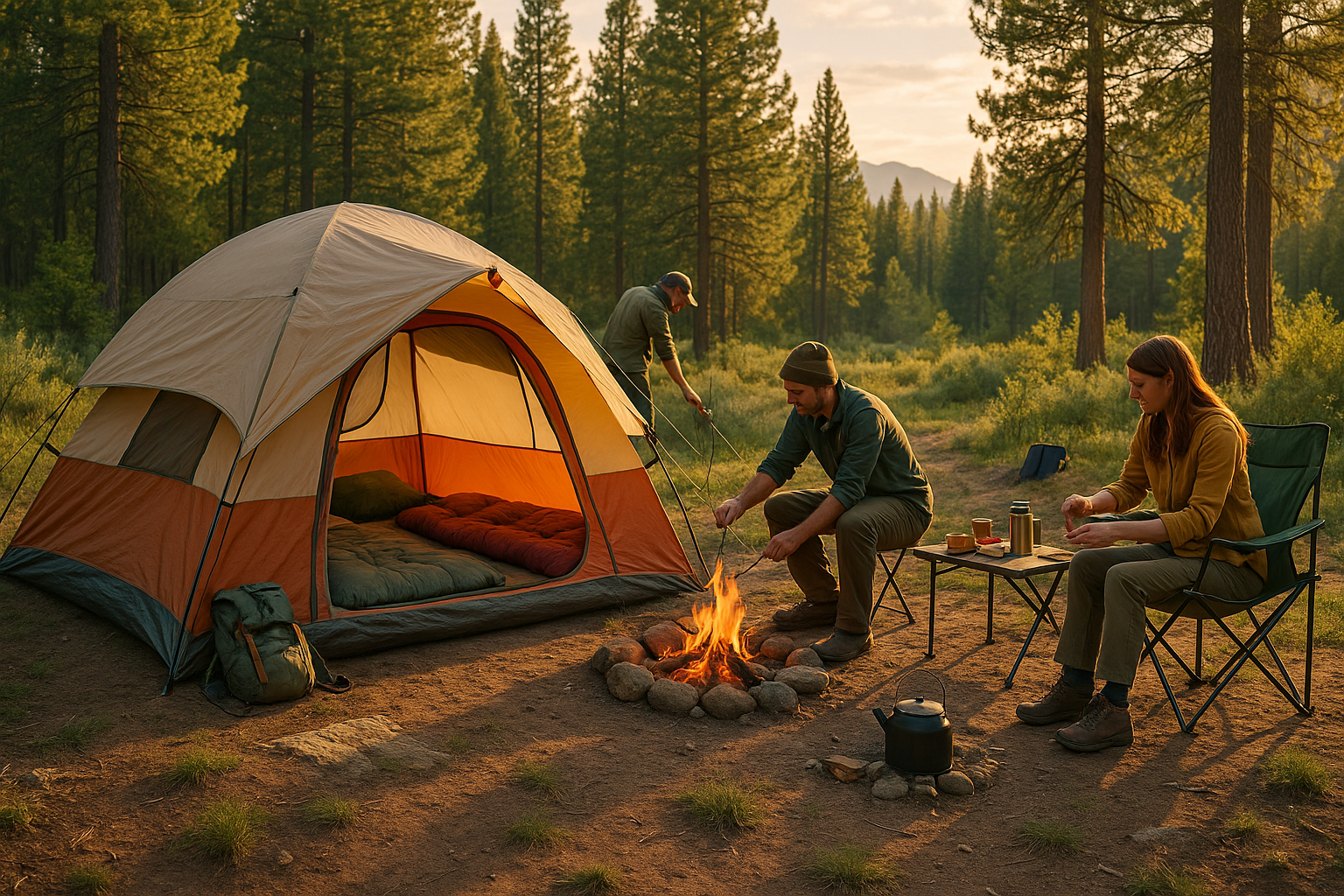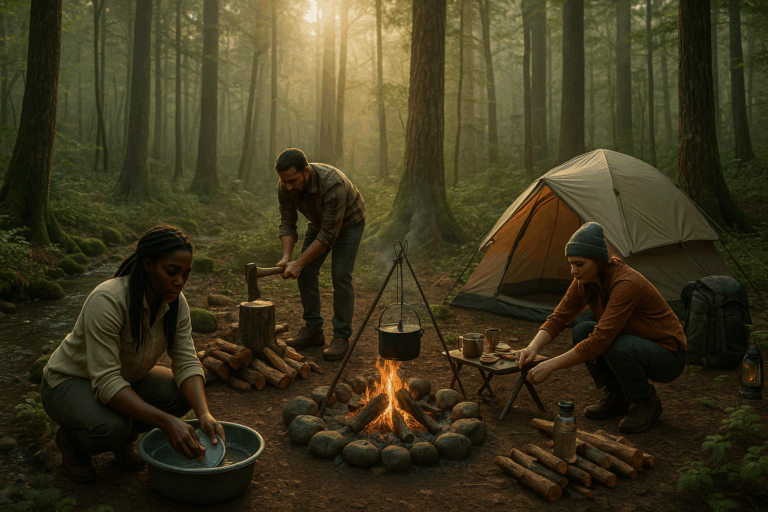Whether it’s the rugged mountain trails that beckon you, the serene lake shores, or the dense, mysterious depths of a forest, camping is an experience that humbles us and reminds us of our primal roots. But for the uninitiated, and even for seasoned adventurers, setting up the perfect tent can be a Herculean task. 😅
In this comprehensive guide, we will unravel the secrets of perfecting your tent setup. We are about to embark on a journey that will transform you from a camping novice to a seasoned outdoor veteran, adept at handling any camping situation with confidence and skill. A journey that will give you an unforgettable camping experience every single time. 🏕️
Why Perfecting Your Tent Setup Matters
The tent is more than just a shelter; it’s your home away from home when you’re in the heart of nature. It’s the cozy cocoon that protects you from the elements, providing you with a warm and dry haven when the weather takes a turn for the worse. A well-pitched tent can mean the difference between a memorable camping trip and a disastrous one. ⛈️
Moreover, perfecting your tent setup is essential for both safety and comfort. A poorly pitched tent can collapse under strong winds, allow water to seep in during a downpour, or let in biting cold during the night. On the other hand, a well-setup tent can provide a secure, comfortable sleeping environment, regardless of the external conditions.
What This Guide Will Cover
This all-encompassing guide will take you through every step of the process, from choosing the right tent and the ideal location to set it up, to troubleshooting common problems and mastering advanced techniques. We’ll dive deep into the core aspects of camping that often go unexplored, from understanding how different terrains affect your setup to mastering the art of adjusting your tent’s ventilation for optimum comfort. 🌬️
For those who have always wanted to master the art of camping but felt daunted by the seeming complexity of it all, this guide will be a revelation. But it’s not just for beginners. Even if you’re a seasoned camper, you’re sure to find some nuggets of wisdom that will elevate your camping game to a whole new level.
Prepare for an Adventure
So buckle up and get ready for an adventure. We’re about to delve into the intricacies of perfecting your tent setup, revealing secrets and tips that will make your next camping trip an unforgettable experience. 🏞️
By the end of this guide, you’ll not only be well-versed in the art of setting up a tent but also equipped with the knowledge to handle any curveball that nature might throw at you. Let’s bring out the intrepid explorer in you and master the great outdoors together!
🏕️ Unveiling the Art of Tent Pitching: The Basics
Embarking on an outdoor adventure is exhilarating, but the key to a memorable experience lies in mastering your tent setup. Whether you’re a novice camper or a seasoned outdoor enthusiast, understanding the intricacies of tent pitching can transform your camping experience from mundane to unforgettable.
Pitching a tent can be a challenging task, especially if you’re not familiar with the technicalities. However, the beauty of this process lies in its simplicity and the sense of accomplishment it offers once you’ve successfully erected your temporary home in the wilderness.
Before delving into the nuances of tent pitching, let’s understand the components of a standard camping tent. This will provide a solid foundation for understanding the process of erecting a tent. Here’s a simple table breaking down the components:
| Component | Description |
|---|---|
| Tent body | This is the main part of the tent, often made of lightweight, breathable fabric. |
| Tent poles | These provide structure and support to the tent body. |
| Rainfly | A waterproof cover designed to protect the tent body from rain or dew. |
| Guylines | These are ropes attached to the tent body or rainfly to increase stability. |
| Stakes | Used to secure the tent and guylines to the ground. |
For a visual demonstration on how these components come together, check out this informative video: “How to Set Up a Tent” by REI on YouTube.
🔨 Mastering the Technique: A Step-by-Step Guide
Having acquainted ourselves with the basic tent components, let’s now walk through the steps of pitching a tent. Remember, practice makes perfect, and the more you familiarize yourself with this process, the more adept you’ll become.
Start by selecting a suitable camping spot. Look for a flat, clear area, free of sharp objects or debris that could damage your tent. Also, consider factors like proximity to water sources, wind direction, and the availability of shade.
Next, lay out your tent body on the chosen spot and stake down the corners. This is an essential step as it anchors your tent to the ground, preventing it from being blown away by strong winds. Now, assemble your tent poles and insert them into the designated sleeves or clips on the tent body. Ensure that the poles are securely fastened and provide a sturdy frame for the tent.
Once the frame is ready, place your rainfly over the tent body. Align it correctly so that all sides of the tent are covered. Secure the rainfly to the tent body using the provided attachments. Finally, stake out your guylines to add extra stability to your tent. Make sure the guylines are tensioned correctly to prevent the tent from collapsing in strong winds.
To see this process in action, watch the video “Camping Tips: How to Set Up a Tent” by TGO Magazine on YouTube.
🛠️ Expert Tips: Optimizing Your Tent Setup
Now that you’ve mastered the basic technique of tent pitching, let’s delve into some expert tips that can take your camping experience to the next level. These tips focus on optimizing your tent setup to ensure comfort, safety, and durability.
One often overlooked aspect of tent pitching is the orientation of the tent. For optimal comfort, align your tent with the prevailing wind direction. This not only ensures good ventilation but also helps keep bugs at bay. Moreover, positioning your tent entrance away from the wind can prevent rain or snow from blowing inside.
Another crucial tip is to use a footprint or groundsheet under your tent. This acts as a barrier between the tent floor and the ground, protecting the tent from abrasion and prolonging its lifespan. Also, remember to tuck the edges of your groundsheet under the tent to prevent rainwater from pooling on it and seeping into your tent.
Lastly, always check and double-check your tent setup before retiring for the night. Ensure all stakes are firmly planted in the ground, the guylines are tensioned correctly, and the rainfly is properly secured. This will save you from unpleasant surprises in the middle of the night.
For more expert tips on optimizing your tent setup, watch the video “10 Tips for Pitching Your Tent” by Camping and Caravanning Club on YouTube.
🎯 The Golden Rule: Practice Makes Perfect
Like any skill, mastering the art of tent pitching requires patience and practice. It’s a good idea to practice setting up your tent at home before heading out on your camping adventure. This not only familiarizes you with your tent and its components but also builds your confidence.
Don’t be disheartened if your first few attempts at pitching a tent aren’t perfect. Each attempt is a learning opportunity, bringing you one step closer to becoming a seasoned camper. Remember, the goal isn’t just to pitch a tent, but to create a comfortable and secure living space in the great outdoors.
So, embrace the challenge, learn from your mistakes, and before you know it, you’ll be pitching tents like a pro. And when you’re comfortably ensconced in your well-pitched tent, listening to the sounds of nature, you’ll realize that mastering the art of tent pitching is truly worth the effort.
For a comprehensive guide to tent pitching, including common mistakes to avoid, watch the video “How to Pitch a Tent – Common Mistakes to Avoid” by Snowys Outdoors on YouTube.
Happy camping!

Conclusion
In this article, we’ve covered a wide array of complex topics, carefully designed to enhance your understanding of the technical aspects of IT and Engineering. We’ve embarked on a journey of exploration, delving into key themes such as software development methodologies, modern infrastructure, cybersecurity, AI, and big data. It’s clear to see the sheer breadth and depth of these fields, with each one bringing unique challenges and opportunities for professionals and organizations alike.
As a recap, we started by dissecting various software development methodologies, including Waterfall and Agile. We highlighted the strengths and weaknesses of each, and how choosing the right approach can significantly impact a project’s success. We also touched on the importance of modern infrastructure, discussing how concepts like cloud computing and containerization are revolutionizing the way we build and deploy software applications. 🌐
From there, we ventured into the fascinating world of cybersecurity. We underscored the critical role of securing digital assets, protecting privacy, and ensuring data integrity. We also covered the most prevalent threats today, such as ransomware, phishing, and DDoS attacks, and how organizations can effectively mitigate these risks. 🛡️
Next, we dived deep into AI and big data. We outlined how these technologies are reshaping industries, providing insights and efficiencies that were unimaginable just a few years ago. From healthcare to finance to retail, we’re witnessing a technological revolution that’s bound to change the world as we know it. 🚀
Throughout this journey, we’ve used real-world examples, industry statistics, and expert opinions, all aimed at enhancing your understanding of these complex topics. However, it’s essential to remember that this is just the tip of the iceberg. There’s much more to learn, explore, and apply.
We sincerely hope that this article has been both informative and inspiring. Each of these topics holds immense potential for innovation and growth, so we encourage you to delve deeper into each one, leveraging the resources provided. Don’t hesitate to comment on this post, sharing your insights and experiences. You can also share this article with your colleagues and friends, helping to spread the knowledge and inspire others. 🌱
In closing, we’d like to leave you with a quote by Benjamin Franklin: “An investment in knowledge pays the best interest.” So, keep learning, keep growing, and let’s continue to push the boundaries of what’s possible with technology.
As always, we appreciate your engagement, and look forward to hearing your thoughts and insights. Here’s to a future filled with innovation, collaboration, and success! 🎯
Additional Sources:
W3Schools
Coursera
Kaggle
References:
ResearchGate
McKinsey
Cisco
IBM



